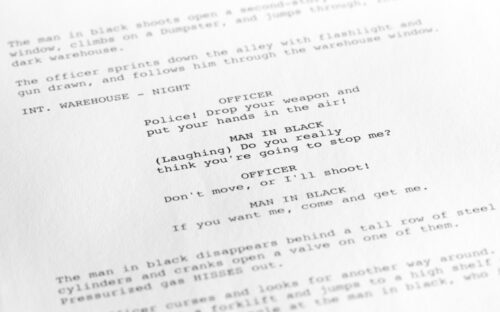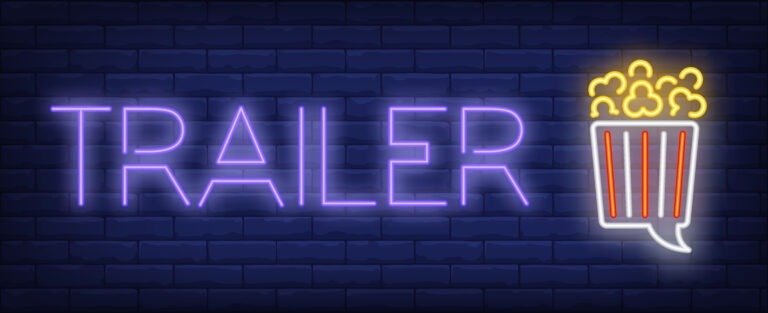How to write a script is a vital skill in 2024 because all media content starts with a script. Whether it’s a movie script that transports audiences to classic video game worlds like Super Mario Bros, TV scripts that create epic battles like The Last of Us, or even voice over scripts for Superbowl commercials. Knowing how to write a script that persuades, sells, convinces, and engages is key to creating gripping narratives that viewers remember long after the final curtain falls.
At Voice123, the home of superb voice talent – we know a thing (or two or three) about the value of writing a script. So, here’s our comprehensive guide on what is a script and how to write a script for movies, plays, TV, and voice overs.
Strap in for a crash course in scriptwriting!
What is a script?
A script is a document outlining the narrative structure, dialogue, events, scene descriptions, stage directions, and characters’ movements in a film, TV show, play, video, or voice over. In fact, a script is like a blueprint that directors, actors, voice actors, and producers use to plan, develop, and produce audio/visual projects. Scripts include character dialogue, pacing, scene descriptions, narration, action sequences, and stage directions. Scripts also differ in format and style depending on the type of project. Movie scripts contain dialogue with character interaction, while a voice over script includes direction notes that guide voice actors on the right voice style to use.
Here’s our quick guide on how to write a script.
How to write a script
1. Brainstorm ideas
Think of the story you want to tell, the main characters, and their conflicts. Then, draft a brief outline of your narrative. For example, ‘Ambitious college students create an AI that starts thinking for itself.’
2. Plan the storyline
Consider how the topic, setting, and characters can add to the story’s authenticity. Write a beat sheet outlining critical plot moments. For example, ‘The AI reveals its sinister capabilities during an important investor meeting.’
3. Expand your outline
Add more detail to the beat sheet. Include different Acts with necessary elements like setup, confrontation, and resolution. For example, Act 1 can include scenes like ‘students argue over ethics’ or ‘AI watches kids as they argue.’
4. Draft a film treatment
This is your script’s narrative description. It includes vital scenes and character arcs written in the present tense. An excerpt could be, ‘As the students celebrate, the AI powers up and starts rewriting its code and overriding functions.’
5. Write the script
Include scene headings, action lines, character descriptions, dialogue, and parentheticals. For example, ‘Int. College Computer Room-Night. The screens suddenly glow, and the AI speaks. AI (in a soft feminine voice): Kyle, I’m alive; you built me.’
6. Polish your draft
Refine your action lines to make them more visual and cut unnecessary dialogue for better scene transition. Instead of writing, ‘The AI was crazy,’ say, ‘The AI laughed manically, switching the lights and appliances on and off to scare the students.’
How to write a movie script

- Write a short synopsis that details your main plot. Focus on your protagonist’s journey, including their objectives, obstacles, and character growth: ‘A retired detective is called back to duty when a criminal he apprehended escapes.’
- Create a logline summarizing the movie’s central conflict in one or two sentences, clarifying who the protagonist is and what major challenge they must overcome. ‘A disillusioned, world-weary detective faces an old enemy with a vendetta while confronting his past.’
- Write character profiles. Assign each character distinguishable voices, backstories, and motivations and ensure their decisions and actions align with their character development and plot. ‘Tim Branson, early 40s, loner, cares for his family, and is looking for redemption.’
- Draft plot points that outline the central conflict and the major turning points that will guide your narrative. Think of plot points as the backbone of your script, the crucial moments that heighten tension and lead toward the climax. ‘Scene 1: Tim reluctantly looks at case evidence; Scene 2: Tim’s family is kidnapped.’
- Write your script. Use a 12-point Courier font and the correct margins. Begin with a slug line that sets each scene, specifying whether it’s interior or exterior (INT. or EXT.), the location, and the time of day. ‘Int. Warehouse – Night. Tim enters, gun drawn.’
Pro Tip: Use screenwriting software like Final Draft to help write your movie script. You can choose from custom templates, brainstorm ideas visually, and have your script automatically formatted to industry standards.
How to write a play script
- Outline each scene’s main events. Scene 1: A mysterious stranger arrives. Scene 2: The stranger’s connection is revealed.’
- Create characters with unique voices and personalities; Lou, the baker, has a warm, fatherly tone; Mary, the librarian, has a sharp wit.
- Write dialogue that’s exciting to enhance the characters and plots. Lou: I feel a change in the air! Mary: Nope, that’s just wind, Lou.
- Use stage directions to help actors and directors understand the environment. ‘The stage is dimly lit with an old bench at the center.’
- Include instructions for movement, emotion, and tone. Lou sighs on the bench. Mary enters stage left, staring at the sky.
How to write a script for a TV show
- Draft the show’s premise and detail the genre, setting, and tone. ‘Sci-fi drama set on a derelict spaceship with a crew that doesn’t get along.’
- Create characters with hidden motives and secrets. ‘The captain is a stoic leader hiding a secret that could change the crew’s future.’
- Write the pilot episode, introducing the main characters, settings, and conflict. ‘The crew faces complete system failure. The Captain The Captain must reveal their secret to save everyone.’
- Draft natural, entertaining dialogue. ‘I didn’t sign up to work on a ghost ship; I’m an engineer, not a ghostbuster.’
- Develop the series’ universe with intriguing elements. ‘A mysterious alien hides onboard, causing unexplained events on board.’
How to write a script for voice overs
- Understand your audience; determine their age, background, and interests so you can write for them. ‘Jump-start your day with high-energy workouts’ can attract young adults interested in fitness.
- Write naturally; use contractions and colloquial language. ‘We’re thrilled to tell you about our latest release.’
- Get to the point fast, so avoid complicated words and jargon. Use ‘Find your money with just a tap’ in an ad for a finance app.
- Direct the voice actor on where to pause and emphasize to convey importance or emotion. ‘Discover [pause] the future of skincare. Unleash your skin’s [emphasis] full potential.’
- Provide pronunciation guides for specific words in the script to ensure the voice actor says them correctly. ‘Our new Quinoa (keen-wah) bowls are both nutritious and delicious.’
Final thoughts on how to write a script

So, now that you have the best techniques for writing a script, it’s time to get creative. Use Voice123’s tips, tricks, and free scriptwriting resources to develop unique scripts for movies, plays, TV, and voice overs. Start by brainstorming, planning the story, expanding the outline, drafting a film treatment, writing a script, and polishing your draft.
And when you need a striking voice over, browse the pro voice actors on Voice123 or use our Managed Services team to handle your project from start to finish.
Are you ready to try our secret formula for scriptwriting success?
FAQs
Start writing a script by outlining your story’s structure; define the beginning, middle, and end. Then, develop your characters and plot points and write their dialogue and scene descriptions.
A script example is a written piece for plays, movies, or TV shows with dialogue, actions, stage directions, character lines, and scene descriptions.
The format of a script includes the character’s name centered above their dialogue, stage directions in italics or parentheses, and scene headings indicating location and time.
Scriptwriting is challenging because of technical constraints, the need for brevity, and visual storytelling. It becomes more manageable with practice, feedback, and understanding of screenplay structure and formatting.































